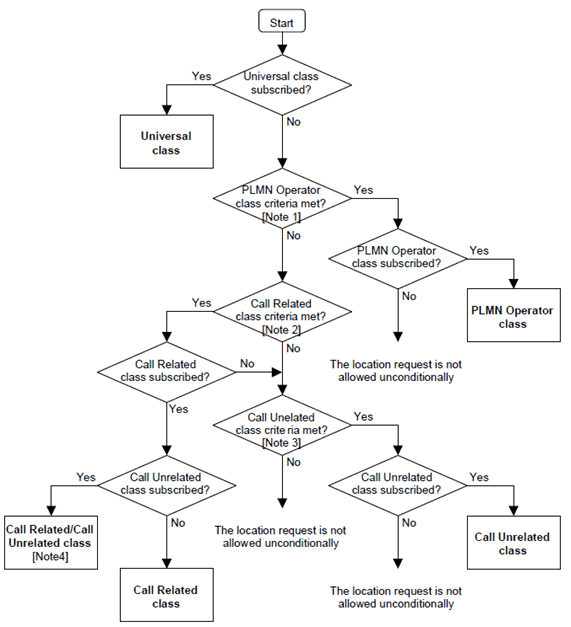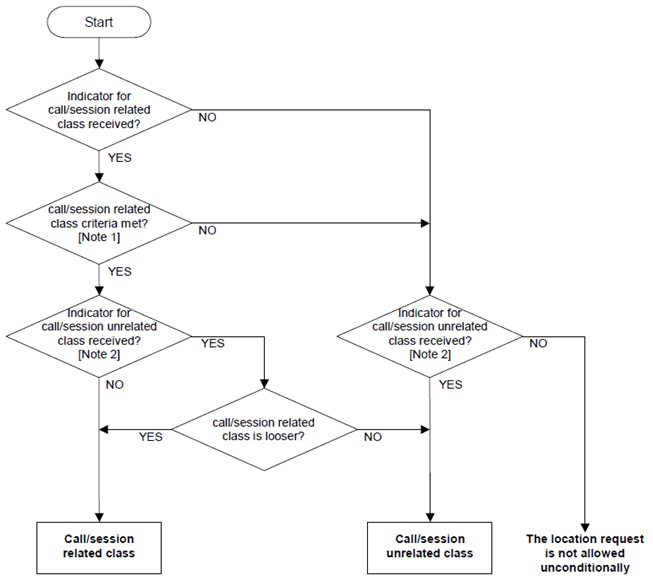Content for TS 23.271 Word version: 18.0.0
1…
5…
6…
6.2…
7…
8…
9…
9.1.1A…
9.1.2…
9.1.5…
9.1.6…
9.1.8…
9.1.9…
9.1.12…
9.1.13…
9.1.15…
9.1.19…
9.2…
9.2.2…
9.2.3…
9.3…
9.4…
9.5…
9.6…
10…
11…
A…
B…
E
F…
A Privacy Class selection rule in serving node
A.1 Interrelation among privacy settings
A.2 Privacy class selection rule for pre Rel-6 mechanism
A.3 Privacy related action selection rule for Rel-6 and later
...
...
A (Normative) Privacy Class selection rule in serving node p. 173
A.1 Interrelation among privacy settings |R6| p. 173
There are five privacy settings and the interrelation among each privacy setting in terms of privacy strictness is shown as follows:
| loose | Positioning allowed without notifying the UE user |
| ↑ | Positioning allowed with notification to the UE user |
| Positioning requires notification and verification by the UE user; positioning is allowed only if granted by the UE user or if there is no response to the notification | |
| ↓ | Positioning requires notification and verification by the UE user; positioning is allowed only if granted by the UE user |
| strict | Positioning not allowed |
A.2 Privacy class selection rule for pre Rel-6 mechanism |R6| p. 173
In pre Rel-6 network, the users privacy profile (SLPP) is stored HLR/HSS and is downloaded to the serving MSC/SGSN. If more than one privacy class are subscribed or in case Service Types and at least one privacy class are subscribed, privacy class for an MT-LR is selected by the serving MSC/SGSN according to the flow diagram shown in Figure A.1.
An MT-LR may be applied to more than one privacy class or to Service Types and one or more privacy classes. In this case, looser privacy setting shall be selected. The privacy settings to be compared are the results of the privacy checks for each applicable class and Service Type.

If the user subscribes Service Types, once that the privacy class has been selected according to Figure A.1, the resulting privacy setting shall be compared with the result of Service Type privacy checking, and the looser condition shall be applied to the MT-LR, provided that the LCS client was authorized by the UE user to get location information.
A.3 Privacy related action selection rule for Rel-6 and later |R6| p. 174
In Rel-6 and later, the privacy checking function is moved from MSC/SGSN to H-GMLC/PPR of the target UE. This is also applied to EPS location request, i.e. privacy checking is done at H-GMLC/PPR of the target UE. H-GMLC/PPR selects one or two indicators of privacy check related action and sends the indicators to serving MSC/SGSN/MME as shown in the clause 9.5.4. If the user subscribes Service Types, the resulting privacy setting shall be compared with the result of Service Type privacy checking, and the looser condition shall be selected. The Service Type check result may be included in any of the two privacy indicators, provided that the MT-LR is allowed for the relative privacy class.
If the serving MSC/SGSN/MME receives the indicators from H-GMLC, the serving node selects the privacy related action according to the flow diagram shown in Figure A.2.

Figure A.2: Privacy related action selection flow diagram of the serving node
(⇒ copy of original 3GPP image)
(⇒ copy of original 3GPP image)